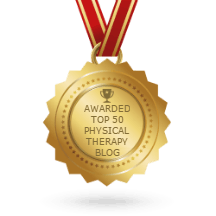It’s easy to feel overwhelmed in today’s marketing landscape.
Everywhere you look, influencers are warning that Google Search is dead, that AI is eating your traffic, and that your clinic website is basically a digital dinosaur. One PT influencer even claimed:
“As AI spreads like a virus across the internet, web traffic from Google searches has dropped 55% over the past 3 years… This is the digital equivalent of people who held off on buying a car and continue to do everything on horseback.”
The implication? If you’re not spending money right now on AI Optimization, your physical therapy clinic might get left behind.
But let’s slow down and take a breath, and discuss physical therapy marketing and AI.
At E-rehab, we are on top of these technologies and trends, more on that below. It helps to have the data from over 1,500 physical therapy clinic locations that we support, to help speak to the specifics of AI marketing and physical therapy private practice.
We’ve seen marketing trends come and go, and we’re here to say this: scare tactics and shiny new objects are distractions from what actually works.
LET ME BE CLEAR-ARTIFICIAL INTELLIGENCE IS ONE OF THE BIGGEST INNOVATIONS AND TECHNOLOGICAL ADVANCEMENTS IN HUMAN HISTORY.
It’s going to continue to impact our profession at an astonishing rate as well, and that includes digital physical therapy marketing with AI, of course.
That said, let’s separate hype from reality and look at what AI means for your website traffic, SEO, and marketing in 2025.
⚠️ The Big Myth: “Website Traffic Is Dropping to Zero”
You may have seen this on a podcast or search result (AI overview, even). It’s sparked a wave of panic—especially among content creators and digital marketers.
Here’s the problem: the data they’re citing applies to large media websites, not local businesses like physical therapy clinics.
Media sites rely on high-volume, top-of-funnel traffic like “What is sciatica?” or “How to stretch hamstrings.” These queries are increasingly being answered by AI directly in search results, reducing the need to click through to full articles.
But you’re not a media outlet. You’re a local business.
And local business SEO is a whole different game.
🍊 Apples vs. Oranges: Local SEO ≠ Publisher SEO
Local SEO focuses on commercial intent: people searching for services they’re ready to use now—like:
- “Physical therapy clinic near me”
- “Best physical therapy in [City]”
- “Sports injury rehabilitation [ZIP Code]”
These are not the kinds of searches being replaced by AI summaries.
In fact, according to Sterling Sky, one of the most respected local SEO agencies in North America:
“We aren’t currently seeing a noticeable decline in local traffic from AI or LLM search tools. For now, Google Business Profiles and local organic traffic are holding strong.”
— Joy Hawkins, Founder of Sterling Sky
So while AI is definitely changing how some people search, its impact on local physical therapy websites is minimal at this stage.
🤖 Are AI Search Tools Sending You Traffic? Not Really (Yet)
Another argument made by AI hype-sellers is that you should be optimizing to appear in Google’s Gemini (AI-generated answers in search results).
Sounds great—except…
Google doesn’t currently give you referral data from Gemini or any other AI Large Language Model (LLM). That means you can’t even see if these tools are sending traffic to your website, because the traffic isn’t measurable.
Worse, there’s little evidence that local clinics are actually benefiting from LLMs at all right now. The few studies available (e.g. by SparkToro and ZipTie) suggest the real shift is happening in zero-click results for informational queries, not local commercial intent searches.
💡 But Could AI Eventually Impact Local SEO?
Absolutely. We’re not saying AI isn’t important—it’s just not urgent for physical therapy practices to throw their budgets into “AI Optimization.”
What matters now is understanding how AI tools like Google Gemini work and how they may eventually affect your visibility in search.
Gemini, for instance, is influenced by:
- Page quality and relevance
- Schema markup
- User engagement signals
- Domain authority
In other words, the same foundational SEO practices you should already be doing.
And that’s where E-rehab helps clinics stay ahead—without the hype.
🧠 Are You Maximizing What Already Works?
Before you invest in experimental marketing strategies, ask yourself:
🔍 “Am I already marketing the way my patients find and buy from me?”
In most cases, the answer is: not completely.
Most PT clinics still have gaps in the basics:
- An outdated website with poor messaging & no calls to action
- Poor Google rankings in their local area
- Weak review profiles
- Lack of educational email marketing to past patients
- No consistent social media presence
Why chase unproven AI tactics when your clinic hasn’t yet maximized the proven ones?
✅ What Should Physical Therapy Clinics Do Right Now?
Here’s a no-hype roadmap for what works today—and will keep working as AI evolves.
1. Double Down on Local SEO
- Optimize your Google Business Profile
- Create locally-relevant service pages (e.g., “Shoulder Pain PT in [City]”)
- Get consistent citations and backlinks from local sources
- Use structured data (schema) on your website
2. Build the Best Online Reputation
- More reviews = more trust = more visibility
- Use tools (like E-rehab’s reputation system) to automate review collection
3. Create High-Quality, Helpful Content
- Write blog posts, FAQs, and videos that answer common patient questions
- Focus on content that builds trust and answers local intent, not broad general topics
4. Keep Your Website Fast, Secure, and Mobile-Friendly
- Google’s Core Web Vitals still matter
- Patients expect a modern, easy-to-navigate site experience
5. Retain Patients Through Email & Social
- Use email newsletters to remind past patients of your expertise
- Stay visible with consistent, branded social media posts
6. Be Prepared for Change – AI Physical Therapy Marketing is Coming
- We can’t say for certain what the future holds, but it’s coming fast.
- 2026-2027 is likely to be the time when AI search, “GEO” (Geographic Engine Optimization) or “AI Optimization” will be a necessary part of your marketing mix.
🔧 What E-rehab Is Doing to Stay Ahead of AI
At E-rehab, we’re not ignoring AI—we’re actively researching and testing how it will impact local search, patient behavior, and clinic marketing. We are:
- Monitoring Google Gemini and Search Generative Experience (SGE) updates
- Evaluating how schema markup and structured data affect AI responses
- Exploring safe, ethical use of AI content tools to improve clinic visibility
- Integrating AI tools into our workflow to save our clients time—not waste their money
But what we’re not doing is pushing fear.
We’re not going to tell you to chase the latest AI hack or dump thousands into a “Gemini optimization” campaign. Instead, we help you focus on what drives real patients through your door—today, tomorrow, and well into the AI era.
🧭 Final Thought: Focus on the Fundamentals
Here’s the truth:
- Website traffic isn’t “dropping to zero” for local physical therapy practices.
- AI isn’t replacing your local presence—it’s evolving alongside it.
- You don’t need to panic, but you do need to stay informed and stay proactive.
At E-rehab, we’re committed to helping you grow your practice with proven, ethical, and evolving strategies that work without the hype.
If you’re ready to cut through the noise and take a confident next step, schedule a strategy session with us today.












